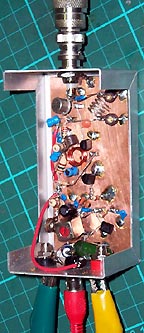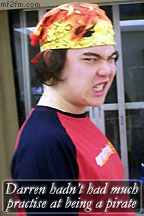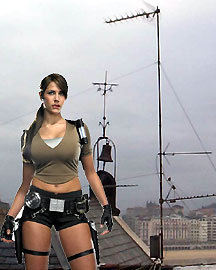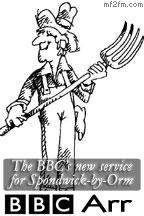Saturday 22 November, 2008, 19:39 - Licensed
Posted by Administrator
Posted by Administrator
 The end of an era is afoot (or at hand, whichever you prefer). Earlier this year the BBC World Service announced that it has stopped transmission of its English service to Western Europe. No longer will the strains of 'Lili Bolero' or 'Big Ben' be heard on the hour in France, Germany or anywhere east of Moscow. Or will it?
The end of an era is afoot (or at hand, whichever you prefer). Earlier this year the BBC World Service announced that it has stopped transmission of its English service to Western Europe. No longer will the strains of 'Lili Bolero' or 'Big Ben' be heard on the hour in France, Germany or anywhere east of Moscow. Or will it?The BBC claim that certain frequencies destined for other parts of the world, notably Western Russia, may still be audible in some parts of Europe for those who absolutely insist on listening to the news from London with loads of hiss, crackle, distortion and fading. But to what extent is this possible? Is World Service short wave reception in Western Europe gone forever or is there still the possibility to listen in?
A scan of the material published by the BBC shows that there are still plenty of transmitters on-air carrying BBC World Service English (albeit different regional variants), pretty much around the clock. The question therefore is whether any of them are audible in Europe.
Whether or not a short wave transmission is audible in any given place depends on a number of factors including the transmission frequency, the time of day (in particular whether the path between transmitter and receiver is in daylight or darkness), the distance between transmitter and receiver and the intended target for the transmission. Take for example the World Service English transmission to Africa from its transmitter site on Ascension Island in the South Atlantic. At various times during the (European) day, this is on a frequency of 17830 kHz. This high frequency propagates well through areas in daylight and the direction of the transmission is roughly the same as the direction from Ascension to most of Europe. The distance between Ascension and Europe requires the transmission to hop into and out of the ionosphere a couple of times but on a normal day, if both ends of the path are in daylight, this should work. Barring any co-channel or strong adjacent channel interference, therefore, the BBC transmission from Ascension should be (and indeed is) audible in Europe.
During the hours of darkness, low frequencies (the 48, 41 and 31 metre band for example) tend to propagate well, whereas during the day, higher frequencies (the 25, 19 and 16 metre bands) will fare better. Taking all this into account, it should be possible to construct a schedule of which BBC World Service English programmes are most likely to be heard in Europe. Of course this will change twice a year as the winter and summer schedules take effect, but the principles should hold true.
With that in mind, here is the Wireless Waffle guide to receiving BBC World Service English in Europe on short wave. The frequencies shown are those that have the best chance of being received in Europe but which are directed to other regions (thus the programming material may not necessarily be appropriate). No account of possible interference has been made (for example it is known that the BBC frequency of 17640 kHz suffers strong adjacent channel interference in Europe from Africa No. 1 on 17630 kHz and China Radio International on 17650 kHz). Other frequencies have strong co-channel and adjacent channel interference too so it's definitely a case of 'if at first you don't succeed, try, try, try again'.
Midnight (GMT) to Dawn
Try:
5970 kHz (from Oman)
6005 kHz (from South Africa/Ascension)
6145 kHz (from Ascension)
6190 kHz (from South Africa)
6195 kHz (from Cyprus)
7105 kHz (from Oman)
7255 kHz (from Ascension)
7320 kHz (from Cyprus)
9410 kHz (from various sites)
9650 kHz (from South Africa)
11760 kHz (from Oman/Cyprus)
11765 kHz (from Oman/Portugal)
12035 kHz (from Cyprus)
12095 kHz (from Cyprus)
Daytime
Try:
11760 kHz (from Oman)
15105 kHz (from South Africa)
15310 kHz (from Thailand)
15400 kHz (from Ascension)
15420 kHz (from Cyprus/South Africa)
17640 kHz (from the Seychelles)
17830 kHz (from Ascension)
21470 kHz (from Ascension)
Dusk to Midnight
Try:
3915 kHz (from Singapore)
5875 kHz (from UK/Cyprus)
5955 kHz (from Oman/Singapore)
6155 kHz (from South Africa)
6190 kHz (from South Africa)
7445 kHz (from South Africa)
12095 kHz (from Cyprus)
Note that these frequencies were taken from the Winter 2008/9 broadcast schedule and may be very out of date if you are reading this in 2013! Also, not all frequencies are on for the whole period (some are not daily either), so you will have to tune around between the ones listed to find the best possible reception for the time you are listening.
add comment
( 1697 views )
| permalink
| 



 ( 3.1 / 95889 )
( 3.1 / 95889 )




 ( 3.1 / 95889 )
( 3.1 / 95889 )
Thursday 13 March, 2008, 08:41 - Pirate/Clandestine
Posted by Administrator
Posted by Administrator
 Finding a frequency must be one of the most fraught tasks for any prospective London pirate radio operators. The band is now so crammed with stations that there are next to no gaps anywhere. The problem is not made any easier by the BBC using lots of frequencies to infill coverage of its local stations; nor by the new wave of community stations taking to the air. Now don't get me wrong, BBC, commercial and community radio stations have a licence and are authorised and legitimate users of the FM band and as such should be respected, and nothing hereinafter should be in any way taken as non-recognition of that important fact. But the fact also remains that pirate radio stations exist and are likely to continue to exist until technology renders them irrelevant and that finding a frequency that doesn't cause interference to these legitimate users, which is a goal to be aimed for if both legal and illegal stations are to co-exist, is nigh-on impossible.
Finding a frequency must be one of the most fraught tasks for any prospective London pirate radio operators. The band is now so crammed with stations that there are next to no gaps anywhere. The problem is not made any easier by the BBC using lots of frequencies to infill coverage of its local stations; nor by the new wave of community stations taking to the air. Now don't get me wrong, BBC, commercial and community radio stations have a licence and are authorised and legitimate users of the FM band and as such should be respected, and nothing hereinafter should be in any way taken as non-recognition of that important fact. But the fact also remains that pirate radio stations exist and are likely to continue to exist until technology renders them irrelevant and that finding a frequency that doesn't cause interference to these legitimate users, which is a goal to be aimed for if both legal and illegal stations are to co-exist, is nigh-on impossible. Since 2000 Ofcom (and its predecessor the Radiocommunications Agency) have been aware (through an oft overlooked study that examined the re-planning of the FM band) that there are small pockets of the FM band that could be used for low-power, limited geographical coverage transmitters in and around London, and it is the results of this study that are, to a large extent, enabling the licensing of the community stations. It's also interesting to note that many of these community stations are using frequencies that were esrtwhile used by pirates. Question: If they can now be used legally for such services without causing interference, can it be completely true that when being used illegally by pirates that the interference they cause was really so bad? Well the power of the community stations is typically less than 100 Watts and they are specifically located in areas where the frequencies they use will not cause interference, whereas the pirates on the same frequencies were often using 250 Watts or more in an attempt to cover a much wider, or a different, area. So it is quite likely that the pirates did cause interference in some areas, but clearly not in others.
Since 2000 Ofcom (and its predecessor the Radiocommunications Agency) have been aware (through an oft overlooked study that examined the re-planning of the FM band) that there are small pockets of the FM band that could be used for low-power, limited geographical coverage transmitters in and around London, and it is the results of this study that are, to a large extent, enabling the licensing of the community stations. It's also interesting to note that many of these community stations are using frequencies that were esrtwhile used by pirates. Question: If they can now be used legally for such services without causing interference, can it be completely true that when being used illegally by pirates that the interference they cause was really so bad? Well the power of the community stations is typically less than 100 Watts and they are specifically located in areas where the frequencies they use will not cause interference, whereas the pirates on the same frequencies were often using 250 Watts or more in an attempt to cover a much wider, or a different, area. So it is quite likely that the pirates did cause interference in some areas, but clearly not in others. One of the interesting side-effects of this use of previous 'pirate' frequencies by the new community stations is that the pirates have been forced to take action to try and maintain their coverage and listenership without causing (too many) problems to the new stations. Blasting several hundred Watts over the top of a new community stations is the perfect recipe to get busted. Hats off, therefore, to Passion FM who, having been forced off their long-time frequency of 91.8 MHz by community station Hayes FM in West London, have taken to using two different frequencies, with directional antennas, to protect Hayes FM yet maintain their service area. Passion can now be found in East London on 91.8 MHz and in West London on 97.9 MHz, thereby making an effort not to interfere with Hayes FM at the expense of having two lots of transmitters to replace each time they are taken off-air.
One of the interesting side-effects of this use of previous 'pirate' frequencies by the new community stations is that the pirates have been forced to take action to try and maintain their coverage and listenership without causing (too many) problems to the new stations. Blasting several hundred Watts over the top of a new community stations is the perfect recipe to get busted. Hats off, therefore, to Passion FM who, having been forced off their long-time frequency of 91.8 MHz by community station Hayes FM in West London, have taken to using two different frequencies, with directional antennas, to protect Hayes FM yet maintain their service area. Passion can now be found in East London on 91.8 MHz and in West London on 97.9 MHz, thereby making an effort not to interfere with Hayes FM at the expense of having two lots of transmitters to replace each time they are taken off-air. West Londoners Point Blank FM also deserve a mention. They are broadcasting to South West London on 103.6 MHz (and thus avoiding Life FM in Harlesden, North London and TGR Sound on 103.7 MHz in South East London) and to Central London on 90.2 MHz, having moved off 108.0 MHz where they used to cause undue interference to Radio Jackie on 107.8 MHz. 108.0 is now used by Unknown FM whose service area, being further East causes fewer problems to Jackie. Both Passion FM and Point Blank FM use the correct RDS Alternative Frequency ('AF') flag so that listeners driving around London will automatically be re-tuned to the clearest frequency - smart! Freeze FM are also 'dual-casting' on 92.7 and 99.5 MHz - it's not clear why but possibly one of the community stations yet to come on-air (Radio Ummah and Irish FM) may use a frequency near 92.7.
West Londoners Point Blank FM also deserve a mention. They are broadcasting to South West London on 103.6 MHz (and thus avoiding Life FM in Harlesden, North London and TGR Sound on 103.7 MHz in South East London) and to Central London on 90.2 MHz, having moved off 108.0 MHz where they used to cause undue interference to Radio Jackie on 107.8 MHz. 108.0 is now used by Unknown FM whose service area, being further East causes fewer problems to Jackie. Both Passion FM and Point Blank FM use the correct RDS Alternative Frequency ('AF') flag so that listeners driving around London will automatically be re-tuned to the clearest frequency - smart! Freeze FM are also 'dual-casting' on 92.7 and 99.5 MHz - it's not clear why but possibly one of the community stations yet to come on-air (Radio Ummah and Irish FM) may use a frequency near 92.7.Pirates are often accused of not caring about interference to other stations, but the actions of these stations would tend to suggest that they do take some care - not least, perhaps, to protect themselves from an excessive number of raids from the authorities.
For the record, other pirate/community frequency clashes that will no doubt resolve themselves in the end are Westside FM (Southhall, West London) and Select-UK (Rotherhithe, South London), both on 89.6 MHz, Nu-Sound (Forest Gate, East London) and Powerjam (Battersea, South London) on 92.0 MHz, and Voice of Africa (Newham, East London) and Tempo on 94.3 and 94.4 MHz respectively.
Wednesday 27 February, 2008, 09:49 - Pirate/Clandestine
Posted by Administrator
Posted by Administrator
 It seems as if Ofcom has been up to its tricks again. On February 19th they announced that they had conducted another large-scale raid on London's pirate radio stations similar to one it conducted in 2005, however this time it was in conjunction with the local council authorities whose buildings are often the home of the pirates' transmitters. 22 transmitters were seized and 3 people were arrested.
It seems as if Ofcom has been up to its tricks again. On February 19th they announced that they had conducted another large-scale raid on London's pirate radio stations similar to one it conducted in 2005, however this time it was in conjunction with the local council authorities whose buildings are often the home of the pirates' transmitters. 22 transmitters were seized and 3 people were arrested.I won't repeat the musings I made last time this happened concerning the probability of pirates causing the kind of wide-spread radio interference they are accused of. The latest news release from Ofcom actually plays down the interference aspects compared to their previous press release, and now plays up the difficulties and dangers that councils face due to the damage caused to property when pirates break into buildings to install their equipment. There can be no doubt that such damage does get caused when pirates break into lift-shafts and onto the rooves of blocks of flats which, if anything, only serves to highlight the desperation that such stations face and their determination to bring the kind of music they play to their audiences. Clearly mainstream radio is not catering for a whole swathe of society.
 Whether or not they are working in cahoots or not, it seems that the BBC is intent on reducing the number of frequencies which might otherwise be useful to community (or pirate!) radio broadcasting. It has recently expanded coverage of 'Three Counties Radio (3CR) by adding relay stations in East Herts, South Herts and High Wycombe. However unlike the majority of other BBC local radio stations, these relays use frequencies in the bands usually used by the BBC for relays of national radio stations (90.4, 92.1 and 98.0 MHz respectively). Now the BBC are quite at liberty to use their own spectrum as they see fit, but this move away from a logically planned system to something more flexible surely suggests that a similarly flexible approach might be taken on a wider basis to allow for frequencies for more, new, innovative radio stations rather than just repeating existing ones. These three frequencies could have been used for new commercial or community stations in these areas. It's not that BBC coverage did not exist there before, it's just that it wasn't quite as good as the BBC had hoped.
Whether or not they are working in cahoots or not, it seems that the BBC is intent on reducing the number of frequencies which might otherwise be useful to community (or pirate!) radio broadcasting. It has recently expanded coverage of 'Three Counties Radio (3CR) by adding relay stations in East Herts, South Herts and High Wycombe. However unlike the majority of other BBC local radio stations, these relays use frequencies in the bands usually used by the BBC for relays of national radio stations (90.4, 92.1 and 98.0 MHz respectively). Now the BBC are quite at liberty to use their own spectrum as they see fit, but this move away from a logically planned system to something more flexible surely suggests that a similarly flexible approach might be taken on a wider basis to allow for frequencies for more, new, innovative radio stations rather than just repeating existing ones. These three frequencies could have been used for new commercial or community stations in these areas. It's not that BBC coverage did not exist there before, it's just that it wasn't quite as good as the BBC had hoped.I still maintain that it's quite possible that pirate stations can (and do) cause interference to legitimate users of the radio spectrum. It's clear, though, that Ofcom is only making small inroads into solving the problem and that other parties are doing nothing to assist. There has to be a long-term solution to the problem if it is ever to be solved and one commentator has suggested that when radio broadcasters have moved over to digital broadcasting (whether DAB, DRM, or something else), some of the 'digital dividend' that results should be given to low power, lightly licensed, radio broadcasting. Sounds like an eminently good idea to me.
Friday 8 February, 2008, 19:10 - Licensed
Posted by Administrator
Posted by Administrator
 The Wireless Waffle team used to supply VHF FM radio transmitters for Restricted Service Licence (RSL) stations in the UK. The licences allowed a maximum transmitter power of 25 Watts and a maximum antenna height of 10 metres above the ground. As such, the range of such stations was normally very limited compared to regular FM stations who used powers typically in excess of 400 Watts and with much higher antennas. To maximise the range of the RSLs, it was best to identify and use transmitter sites which were as high above the surrounding land as possible but in some areas the land was so flat that no such sites existed.
The Wireless Waffle team used to supply VHF FM radio transmitters for Restricted Service Licence (RSL) stations in the UK. The licences allowed a maximum transmitter power of 25 Watts and a maximum antenna height of 10 metres above the ground. As such, the range of such stations was normally very limited compared to regular FM stations who used powers typically in excess of 400 Watts and with much higher antennas. To maximise the range of the RSLs, it was best to identify and use transmitter sites which were as high above the surrounding land as possible but in some areas the land was so flat that no such sites existed.One question which was constantly asked by the operators of such stations was, "Should I broadcast in stereo?". On the face of it, stereo is the norm for FM broadcasts and most stations believed that if they weren't in stereo they would be seen somehow as inferior. However, what most failed to take into account was the fact that in order to receive a good quality stereo signal, the signal strength has to be 10 times (20dB) higher than that required to receive a good quality mono signal. This translates into a reduction in coverage area of 100 times, i.e. the coverage in stereo is only a hundredth of the coverage area achieved by the same transmitter in mono (ignoring topographical issues such as terrain and buildings).
Why is there so much difference? The answer lies in the bandwidth which a stereo signal occupies compared to a mono signal. The audio bandwidth of an FM transmission lies in the range of 30 Hz to 15000 Hz (15 kHz). However the way that a stereo signal is generated expands this bandwidth to 53000 Hz (53 kHz). (Don't get this confused with the RF bandwidth of the signal which is 180 kHz for mono and 256 kHz for stereo).
 How does the audio bandwidth extend to 53 kHz? Well the mono signal which is made by adding the left (L) and right (R) channels together - expressed as L+R - is transmitted as usual so that the resulting signal is compatible with mono receivers. The difference between the left and right channel (L-R) is amplitude modulated onto a carrier at 38000 Hz (38kHz). This produces a signal which occupies the audio frequencies from 23 to 53 kHz - above the standard audio range and thus inaudible on a mono receiver.
How does the audio bandwidth extend to 53 kHz? Well the mono signal which is made by adding the left (L) and right (R) channels together - expressed as L+R - is transmitted as usual so that the resulting signal is compatible with mono receivers. The difference between the left and right channel (L-R) is amplitude modulated onto a carrier at 38000 Hz (38kHz). This produces a signal which occupies the audio frequencies from 23 to 53 kHz - above the standard audio range and thus inaudible on a mono receiver.A 'pilot' tone which is a low-level tone at 19000 Hz (19kHz) is also added to this signal and then the whole lot is sent to the FM transmitter. In a stereo receiver the presence of the pilot tone triggers the stereo decoder to recover the original signals. The left channel is reproduced by adding the mono to the stereo difference signal (L+R+L-R=2L) and the right channel is produced by subtracting the difference signal from the mono signal (L+R-(L-R)=L+R-L+R=2R).
The noise received by an FM receiver increases as the square of the bandwidth of the modulated/demodulated signal and as such the increase in noise (i.e. the decrease in signal to noise) for a stereo signal is (53/15)² or 12.5 times. Some of this increase is counterbalanced by 'pre-emphasis' where higher audio frequencies are enhanced before transmission and then reduced at the receiver, reducing the effect of some of the noise. The resulting improvement leaves a difference of the factor of 10 mentioned above.
 The question of whether to broadcast in stereo for a low-power RSL (or indeed a pirate!) FM station is therefore a question of quality and coverage. If you have a high site and can expect that most of the listeners you wish to target will receive a good strong signal, stereo is great. If not (which is usually the case), using mono ensures your coverage is maximised. Of course, in fringe stereo areas where the signal becomes 'hissy' the listeners could always switch to mono, but how many people actually know that this solves the problem, let alone know where the mono/stereo switch on their receiver is?!
The question of whether to broadcast in stereo for a low-power RSL (or indeed a pirate!) FM station is therefore a question of quality and coverage. If you have a high site and can expect that most of the listeners you wish to target will receive a good strong signal, stereo is great. If not (which is usually the case), using mono ensures your coverage is maximised. Of course, in fringe stereo areas where the signal becomes 'hissy' the listeners could always switch to mono, but how many people actually know that this solves the problem, let alone know where the mono/stereo switch on their receiver is?!There are some pirate stations who transmit only the pilot tone so that the stereo 'light' on receivers comes on, which looks nice, but don't actually transmit in stereo. This is the worst possible case, as all it will serve to do is reduce the coverage, without giving any additional benefit to the listeners!


